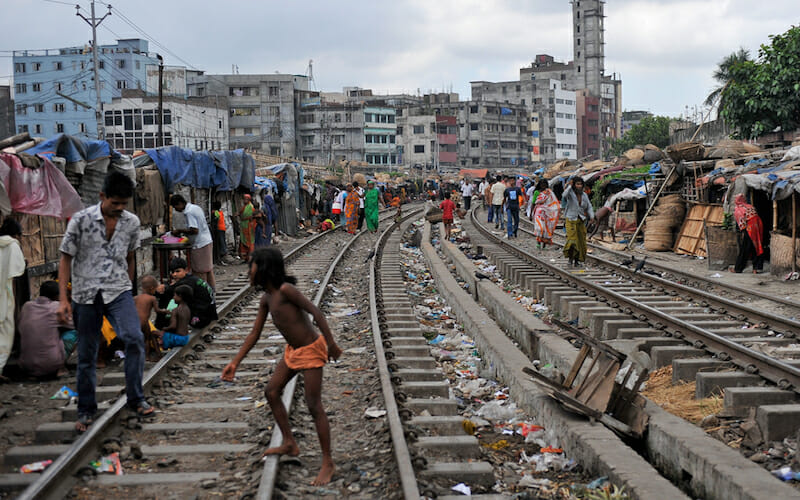
What Waits for Bangladesh as it Becomes a ‘Developing Country’?
As Bangladesh, a country of more than 160 million people and an economy worth $686.5 billion, enters a stipulated six-year graduation period to become a “developing country” by 2024, policymakers expect a few rough patches ahead.
In recent times Bangladesh has met the criteria for graduation from the status of least developed country (LDC) for the first time, according to the Bangladesh mission at the UN. The CDP measures the LDC category on the basis of per capita income, GNI, a human assets index (HAI) and an economic vulnerability index (EVI). A country must exceed thresholds on two of the three criteria at two consecutive triennial reviews to be considered for graduation.
The CDP reviews the list of LDCs every three years and makes recommendations on the inclusion and graduation of eligible countries. The last review was done in 2015 when three countries, including Nepal and Bhutan, became eligible for graduation from the LDC bloc. The scores required for graduation from the LDC category are a per-capita GNI of $1,230 or above, an HAI of 66 or above, and an EVI of 32 or below. Bangladesh’s current GNI per capita is $1,724, its HAI is 72 and EVI is 25.2.
The CDP will review Bangladesh’s progress in 2021, followed by the country’s official graduation from the LDC category after a three-year transition period. If the country maintains its position in all three categories for the next six years, it will eventually graduate from the LDC bloc by 2024. Following graduation in 2024 the country will probably be given a three-year transition period before it loses duty-free, quota-free market access to the European Union under the Everything but Arms initiative for LDCs. After 2027, provided that it ratifies 27 conventions on human and labor rights, environment and governance, Bangladesh may be expected to gain access to the Generalized System of Preferences Plus (GSP+), giving it dedicated preferential tariff rates.
The most observable trade-related ramification of LDC graduation is the loss of preferential market access, such as the EU’s EVA initiative and of the concessions granted to the LDCs under the global system of trade preferences (GSTP) among the developing countries. The LDCs are now enjoying the tariff concession and are also exempted for the trade-related aspects of intellectual property rights (TRIPS) agreement. If these countries lose these facilities, that’ll result in a rise of the cost of products and administrative burdens. Possible benefits of the duty-free and quota-free access include: (1) higher prices of existing exports, (2) price gains from diverting sales from other export markets or domestic markets, (3) increased value added through expansion of production. The graduation from LDC will gradually close down these preferential trade opportunities.
The probable impact of Bangladesh’s loss of preferential facilities in major export destinations will be felt on the export, sustainable GDP growth and other socio-economic indicators e.g. poverty and employment generation as the cost of overseas funds will increase. The transition process has to be smooth in a gradual and predictable manner so that it does not disrupt the development progress of the graduating country. Otherwise, Bangladesh will lose exports between 5.5 per cent and 7.5 per cent as per an UNCTAD projection in 2016.
The developing countries and development agencies take into consideration the status of the recipient countries for loan, grant etc. The LDCs or other low-income countries (LICs) get loans at easier terms and conditions compared to the loan provided under the same conditions to a middle-income country (MIC). The development progress underlying graduation should, in principle, give rise to a progressive reduction in the need for ODA and other concessional financing during the course of the pre-graduation period.
Bangladesh should now be prepared for the probable impact of graduation and build capacity to retain the export market and enhance internal capacity to finance development programmes. So it is high time for Bangladesh to formulate effective strategies to ensure its successful graduation from the LDC group as such graduation is going to take place at a time when the global and regional situation is not favorable. The strategies should be made to face the challenges because after graduation from the LDC group Bangladesh will have to take foreign loans at high interest rates. Steps will have to be taken to boost productivity as the overall international trade facilities will come down.
Sustained economic growth has rapidly increased the demand for energy, transport and urbanization. Insufficient planning and investment have resulted in increasingly severe infrastructure bottlenecks. To achieve its growth aspiration of becoming upper-middle income country by 2021, the country needs urgently to implement structural reforms, expand investments in human capital, increase female labor force participation, and raise productivity through increased global value chain integration. Improving infrastructure as well as the business climate will allow new productive sectors to develop and generate jobs.
Bangladesh is both a motivation and a challenge for policymakers and practitioners of development. While income growth, human development and vulnerability reduction efforts to date have been extraordinary, Bangladesh faces daunting challenges with about 22 million people still living below the poverty line. The country is at an important juncture, when with the right policies and timely action, it can move up within the middle-income bracket. The World Bank has identified job creation as the country’s top development priority. Bangladesh needs to create more and better jobs for the 2 million youths entering the job market every year. To do so, Bangladesh will need to remove the barriers to higher growth posed by low access to reliable and affordable power, poor transportation infrastructure, limited availability of serviced land, uncertain and complex business regulation, rapid urbanization and vulnerability to climate change and natural disasters, among others.

